|
|
|
Sort Order |
|
|
|
Items / Page
|
|
|
|
|
|
|
| Srl | Item |
| 1 |
ID:
140662


|
|
|
|
|
| Publication |
Princeton, Brandon/systems press, Inc., 1970.
|
| Description |
ix, 181p.hbk
|
| Standard Number |
877690286
|
|
|
|
|
|
|
|
|
|
|
|
Copies: C:1/I:0,R:0,Q:0
Circulation
| Accession# | Call# | Current Location | Status | Policy | Location |
| 005493 | 658.4033/ENR 005493 | Main | On Shelf | General | |
|
|
|
|
| 2 |
ID:
125856
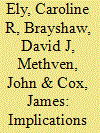

|
|
|
|
|
| Publication |
2013.
|
| Summary/Abstract |
UK wind-power capacity is increasing and new transmission links are proposed with Norway, where hydropower dominates the electricity mix. Weather affects both these renewable resources and the demand for electricity. The dominant large-scale pattern of Euro-Atlantic atmospheric variability is the North Atlantic Oscillation (NAO), associated with positive correlations in wind, temperature and precipitation over northern Europe. The NAO's effect on wind-power and demand in the UK and Norway is examined, focussing on March when Norwegian hydropower reserves are low and the combined power system might be most susceptible to atmospheric variations. The NCEP/NCAR meteorological reanalysis dataset (1948-2010) is used to drive simple models for demand and wind-power, and 'demand-net-wind' (DNW) is estimated for positive, neutral and negative NAO states. Cold, calm conditions in NAO- cause increased demand and decreased wind-power compared to other NAO states. Under a 2020 wind-power capacity scenario, the increase in DNW in NAO- relative to NAO neutral is equivalent to nearly 25% of the present-day average rate of March Norwegian hydropower usage. As the NAO varies on long timescales (months to decades), and there is potentially some skill in monthly predictions, we argue that it is important to understand its impact on European power systems.
|
|
|
|
|
|
|
|
|
|
|
|
|
|
|
|
| 3 |
ID:
113794
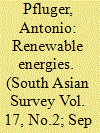

|
|
|
|
|
| Publication |
2010.
|
| Summary/Abstract |
Energy efficiency and energy conservation are the cornerstones of win-win strategies for reducing emissions while fostering economic development. Renewable energies can technically contribute to practically all sectors of energy demand, that is, fuel for transportation, electricity, low temperature heat for space heating and hot water and, to a limited degree, to high temperature process heat. However, costs and variability are the two major security concerns regarding renewable energies. An improvement of energy security by using renewable energies is possible but it causes additional costs. However, a sufficiently widespread variety of energy sources implies the acceptance of a certain spread of costs in any case. This means that efforts to improve energy security do not come for free. More secure energy systems require higher costs and thus, higher energy prices.
|
|
|
|
|
|
|
|
|
|
|
|
|
|
|
|
| 4 |
ID:
116711
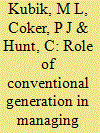

|
|
|
|
|
| Publication |
2012.
|
| Summary/Abstract |
As electricity systems incorporate increasing levels of variable renewable generation, conventional plant will be required to operate more flexibly, with potential impacts for economic viability and reliability. Northern Ireland is pursuing an ambitious target of 40% of electricity to be supplied from renewable sources by 2020. The dominant source of this energy is anticipated to come from inherently variable wind power, one of the most mature renewable technologies. Conventional thermal generators will have a significant role to play in maintaining security of supply. However, running conventional generation more flexibly in order to cater for a wind led regime can reduce its efficiency, as well as shortening its lifespan and increasing O&M costs. This paper examines the impacts of variable operation on existing fossil fuel based generators, with a particular focus on Northern Ireland. Access to plant operators and industry experts has provided insight not currently evident in the energy literature. Characteristics of plant operation and the market framework are identified that present significant challenges in moving to the proposed levels of wind penetration. Opportunities for increasing flexible operation are proposed and future research needs identified.
|
|
|
|
|
|
|
|
|
|
|
|
|
|
|
|
| 5 |
ID:
150007
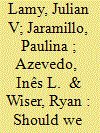

|
|
|
|
|
| Summary/Abstract |
Wind speeds in remote areas are sometimes very high, but transmission costs to access these locations can be prohibitive. We present a conceptual model to estimate the economics of accessing high quality wind resources in remote areas to comply with renewable energy policy targets, and apply the model to the Midwestern grid (MISO) as a case study. We assess the goal of providing 40 TWh of new wind generation while minimizing costs, and include temporal aspects of wind power (variability costs and correlation to market prices) as well as total wind power produced from different farms. We find that building wind farms in North/South Dakota (windiest states) compared to Illinois (less windy, but close to load) would only be economical if the incremental transmission costs to access them were below $360/kW of wind capacity (break-even value). Historically, the incremental transmission costs for wind development in North/South Dakota compared to in Illinois are about twice this value. However, the break-even incremental transmission cost for wind farms in Minnesota/Iowa (also windy states) is $250/kW, which is consistent with historical costs. We conclude that wind development in Minnesota/Iowa is likely more economical to meet MISO renewable targets compared to North/South Dakota or Illinois.
|
|
|
|
|
|
|
|
|
|
|
|
|
|
|
|
| 6 |
ID:
163289
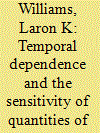

|
|
|
|
|
| Summary/Abstract |
Scholars of international relations increasingly use temporal dependence variables (polynomials or splines) to control for unmodeled duration dependence in nonlinear models (such as logit or probit) of events ranging from interstate conflict and civil war to sanctions imposition and trade agreements. I identify two inferential obstacles that are widespread to nonlinear models, and are exacerbated by the unique features of temporal dependence variables. First, compression causes the quantities of interest to be sensitive to the values in the counterfactual scenario (most notably, time). Second, presenting substantive effects calculated at one simulation scenario (such as an “average” scenario) grossly inflates the representativeness of that scenario and neglects the variability within the sample. The consequences of these problems range in severity from understating the magnitude of the substantive effects to deriving inferences that are wholly unrepresentative of the data. I offer a simple checklist. First, use the values observed in the data to generate in-sample quantities of interest. Second, plot those quantities of interest across the offending variable (for example, time) and interpret the relationship. Finally, provide a sense of the sample's variability in quantities of interest through simple summary statistics (such as mean, standard deviation, and range). These simple fixes provide much-needed transparency and act as a shield against scholars who might otherwise present misleading results.
|
|
|
|
|
|
|
|
|
|
|
|
|
|
|
|
|
|
|
|
|